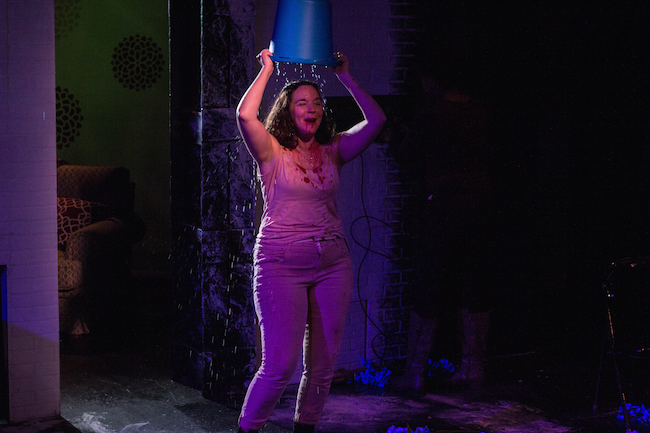Theater Review: Missing the Irony in “Revolt. She Said. Revolt Again.”
Alice Birch’s play/polemic about radical feminism resists Company One’s earnest-to-the-max interpretation.
Revolt. She Said. Revolt Again. By Alice Birch. Directed by Summer L. Williams. Presented by Company One at the Boston Center for the Arts. Boston, MA, through November 19.

Bottom to top: Christa Brown, Jeff Marcus, and Ally Dawson in a scene from Company One’s production of “Revolt. She Said. Revolt Again.” Photo: Paul Fox.
By Ian Thal
Alice Birch’s Revolt. She Said. Revolt Again. isn’t so much a play as a series of sketches, each preceded by imperative projections, such as “REVOLUTIONIZE THE LANGUAGE. (INVERT IT)” or “REVOLUTIONIZE THE WORLD. (DO NOT MARRY).” These shout-outs are presumably excerpts from a manifesto, but they also recall the linguistic practices of conceptual artists Jenny Holzer and Barbara Kruger, who came to prominence in the late 1970s. Most of the characters in these short pieces are unnamed, and Birch largely leaves it up to the director (Summer L. Williams in the Company One production) to determine how the dialogue and actions are distributed among the actors. Much of the dialogue sounds as if it was taken from an ideological tract or lifted from an arch-parody of this kind of propaganda.
In the first sketch, a heterosexual couple returns home from a date that involves cheese, watermelon, and human rights abuses in North Korea. When the man (Jeff Marcus) talks about the sex he has fantasized about all evening, the woman (Becca A. Lewis) analyzes his rhetoric. For example: Why not “make love with” instead of “make love to.” She parses his fantasies as if he is the subject and she is the object of the verb (or, at best, the subject of a passive verb) in each sentence. She then counters with a fantasy where she is the active subject. There are some funny bits (including a humorously choreographed coitus designed by Misha Shields). Ultimately, though, I was reminded of the point made by an article about feminist erotica in (I believe) The Village Voice circa 1990 – a quaint time before high-speed internet, when people actually read pornography.
Along with old-fashioned prejudices, women are oppressed in all sorts of new and different ways because of their gender. But Birch seems to be pretty well stuck in time, engaging with ideas popular in an earlier era of feminist thought, particularly the call for a ‘womanist’ revolution whose goal would be a utopia sans men (no transgender people either).
In dramaturg Jessie Baxter’s program notes, she notes that Birch has drawn inspiration from Valerie Solanas’ 1967 SCUM Manifesto (“SCUM” being an acronym for “Society for Cutting Up Men”). Baxter places the SCUM Manifesto in the tradition of feminist utopian thought – imagining a perfect world without men – but she ignores the one time Solanas put her philosophy into practice: her failed 1968 assassination attempt of Andy Warhol (dramatized in Mary Harron’s 1996 film, I Shot Andy Warhol) that left the pop-artist and gay icon severely wounded. Solanas was diagnosed with paranoid schizophrenia and was sentenced to three years in prison, including treatment in a mental hospital. The notoriety created a cult-following for her book. Upon release she returned to stalking and harassing Warhol – and she was arrested again.
This is not the only crucial piece of historical omission in Baxter’s survey: she mentions Wonder Woman and her Paradise Island homeland, but leaves out that Wonder Woman was the creation of Boston University psychology professor and inventor of the polygraph test, William Moulton Martson (writing as Charles Moulton), a bondage enthusiast who lived in a ménage-à-trois with his wife and his former student. (Incidentally, the image of the heroine used in the program is from 1975’s Wonder Woman #216 – written by Elliot S! Maggin, illustrated by Nick Cardy.) The history of a feminist utopia, like most dreams of paradise, has been unruly and paradoxical, to say the least.
Easily the most powerful moment in Revolt. She Said. Revolt Again. is the soliloquy (ably delivered by Lewis) at the end of “REVOLUTIONIZE THE BODY (MAKE IT SEXUALLY AVAILABLE. CONSTANTLY).” Grocery store managers catch a woman lying down in aisle seven exposing herself. Their inquiry ends with a crescendo of fat-shaming insults (though only by the standards of Hollywood and the fashion industry is anyone in the C1 cast “fat”). The woman speaks, describing her personal history of body dysmorphia, of radically attacking her skin, hair, her internal organs. She is obsessed with erasing the line “[w]here [her] body stops and the air around it starts,” of eradicating her selfhood and sexual agency. She is obviously psychotic.

Becca A. Lewis in a scene from Company One’s production of “Revolt. She Said. Revolt Again.” Photo: Paul Fox.
Lewis takes all of this rhetoric head-on and right-on, but it could be argued that Birch’s play resists Company One’s one-note, earnest-to-the-max interpretation. Are these commands to REVOLT a serious instigation for political change or symptoms of madness? Birch’s play suggests that these violent messages, whatever political inspiration they give, are also more than a little disturbed, even unhinged. In other words, Birch is satirizing these extreme ideas, in much the same way she lampoons the patriarchy. She offers no alternatives, only a scathing dismissal of both radical polarities. Christa Brown summarizes the show’s desire in the final soliloquy – “we stopped watching and checking and nurturing the thought to become the action.” The irony is that no plausible thought has been uttered.
Company One irons Birch’s ironies flat, leaving the production of this fascinatingly weird but flawed script floundering, the actors often left high and dry. Why would a feminist rhetorician be more alarmed about her paramour’s use of prepositions than his confession he can’t take his mind off of sex during a discussion of human rights violations in North Korea? What sort of person rejects a marriage proposal by gas-lighting her lover with a critique of the institution as chattel slavery? Maybe the same sort of person who proclaims “our bleeding heart liberalism [has greater] empathy towards [..] suicide bombers” than towards the people they murder and maim.
The script is messy, anarchic, and I can’t help but wish I had seen it staged by a different company, one whose director and dramaturg had read the text more deeply, had been more appreciative of its rabidly sardonic qualities. Prop designer Nick Robinette supplies the most creative engagement with the text, coming up with a nicely comic riff on the line ‘hymens for sale’ in a manner that evokes photographer Cindy Sherman’s early ’90s work.
Ultimately, the most telling (and radical?) irony comes at the show’s end. Three women echo Solanas’ call to “dismantle the monetary system […] overthrow the government [ … and] eradicate all men.” At this point in time, radical feminism mainly exists as a paranoid fantasy evangelized by insecure misogynists (Rush Limbaugh’s ‘feminazis’). When it comes to the real world, a different sort of feminist is staking a claim to genuine power, its figurehead a self-proclaimed cool-headed pragmatist who is now very likely to become the next president of the United States.
Ian Thal is a playwright, performer, and theater educator specializing in mime, commedia dell’arte, and puppetry, and has been known to act on Boston area stages from time to time, sometimes with Teatro delle Maschere. He has performed his one-man show, Arlecchino Am Ravenous, in numerous venues in Massachusetts and Rhode Island. One of his as-of-yet unproduced full-length plays was picketed by a Hamas supporter during a staged reading. He is looking for a home for his latest play, The Conversos of Venice, which is a thematic deconstruction of Shakespeare’s The Merchant of Venice. Formerly the community editor at The Jewish Advocate, he blogs irregularly at the unimaginatively entitled The Journals of Ian Thal, and writes the “Nothing But Trouble” column for The Clyde Fitch Report.
Tagged: Alice Birch, Company One, Radical feminism, Revolt. She Said. Revolt Again.
